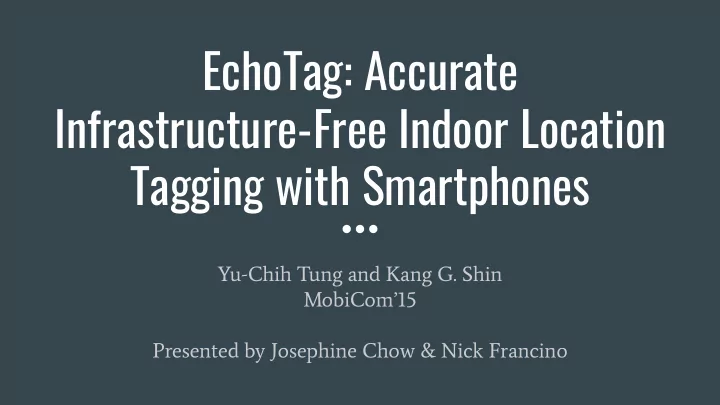

EchoTag: Accurate Infrastructure-Free Indoor Location Tagging with Smartphones Yu-Chih Tung and Kang G. Shin MobiCom’15 Presented by Josephine Chow & Nick Francino
Intuition
EchoTag ● Uses this intuition to implement indoor location “tagging” ● A tag is a location and associated actions ○ Phone could go to silent in class Phone could automatically set an alarm in the bedroom ○ ● Tags are created when user places phone at specific location Phone “learns” location by emitting an audio signal ○ ● Phones “remember” where they are based on received audio … and perform pre-defined actions ○
Using EchoTag - Drawing tags ● Help users remember tag location ● Can draw on paper and tape on surfaces
Using EchoTag - Sense acoustic signatures ● Use phone’s speaker to play a sound ● Use phone’s microphone to record echo
Using EchoTag - Select mapped applications ● Users specify and associate different actions with different tagged locations
Using EchoTag - Replay recorded tags ● Put phone back to tagged location to replay actions specified by users
EchoTag: Use cases
(How well) does it work? ● In a “perfect” environment Can distinguish 11 tags at 1cm resolution with 98% accuracy ○ Maintains 90% accuracy over a week ○ ● Introducing foreign objects to room Reduces accuracy to 56% ○
(How well) does it work?
Implementing EchoTag ● Create an acoustic signature that is unique to a location ○ Must be robust to “spacial” and temporal changes ● Classification based on signature ○ Uses generic classifiers ● Usability ○ Is EchoTag useful? Obtrusive?
Acoustic Signature ● (Ideally) unique sound features that can identify location ● Training phase; phone emits a signal, records received echo. ● Features extracted from echo, mapped into large dimensional space for classification ● EchoTag uses Frequency Domain signatures (11-22Khz) Depends on differing absorption across frequencies ○ ● Acoustic signature augmented with wifi AP visibility and tilt sensor
Acoustic Signature
Uneven Attenuation
Acoustic signature generation
Classification ● Uses off-the-shelf classifiers ● Paper discusses K Nearest Neighbor (kNN) and Support Vector Machine (SVM) ● 200 features (samples after the first peak)
kNN ● 5 nearest neighbor using Euclidean distance ● 65% accurate over 1 cm resolution Small training data, and non-linear acoustic signals ○
SVM One-against-all SVM ● N classifiers trained for N tags ● ● Location classified as tag #k if the kth classifier provides highest probability Probability <50% means no tag is active ○ Provides 98% accuracy over 1cm resolution ●
Optimization Continuous audio sensing is expensive in terms of power ● EchoTag generates audio, which is obtrusive ● EchoTag is activated only if inertial sensor detects no motion ● Locations coarsely classified using WiFI AP ids ● ○ EchoTag not activated if known APs are not detected
Tolerance Range Can decrease sensing frequency in order to increase tolerance ● This allows for it to be less accurate, which could be useful ○ Also, implementing a “No Tag SVM” instead of trying to locate a tag ● ○ In there test had only 1% false negatives
Optimization
Usability
Summary EchoTag uses acoustic sensing for indoor localization ● Actions associated with locations ● Acoustic signature based on frequency absorption ● ● 98% accuracy, 1cm resolution using all-against-one SVM Not particularly robust to environment ● User study to gauge utility ●
Related Work
Recommend
More recommend